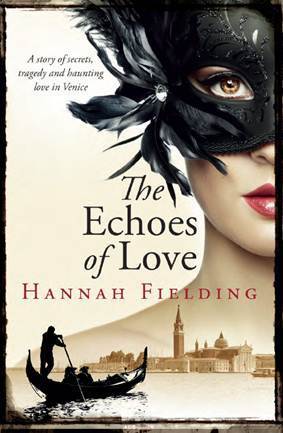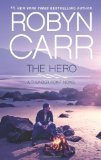Hannah Fielding's Blog, page 123
September 6, 2013
Book review: The Hero by Robyn Carr
Book review: The Hero by Robyn Carr
From the blurb:
In a moment of desperation, Devon McAllister takes her daughter and flees a place where they should have been safe and secure. She has no idea what is around the next bend, but she is pretty certain it can’t be worse than what they’ve left behind. Her plan is to escape to somewhere she can be invisible. Instead, an unexpected offer of assistance leads her to Thunder Point, a tiny Oregon town with a willingness to help someone in need.
As the widowed father of a vulnerable young boy, Spencer Lawson knows something about needing friendship. But he’s not looking for anything else. Instead, he’s thrown his energy into his new role as Thunder Point’s high school football coach. Tough and demanding to his team, off the field he’s gentle and kind, just the kind of man who could heal Devon’s wounded heart.
Devon thought she wanted to hide from the world. But in Thunder Point, you find bravery where you least expect it, and sometimes, you find a hero.
From the first page of this book, I was hooked. The story is compelling, and as a reader I so wanted to see Devon escape and build a life of security. The writing really keeps you on the edge of your seat at times, and throughout the book the threat of Devon’s past lingers, so that you know a dramatic climax indeed is coming.
I liked Devon as a character, though I’d perhaps have liked a little more emotional exploration, and I liked her relationship with Spencer. But what really stands out in the book is the town, Thunder Point – such a wonderful sense of community that reading this book is heart-warming and pure escapism. There are more stories at play here than the book’s blurb suggests, and I found myself interested in all of the characters – but most of all with Devon and her little girl, Mercy.
I found the exploration of what it is to be a woman in a commune (effectively a cult) very interesting and intelligently drawn. Rather than thinking Devon silly to have ever got involved in such a place, we see how the abusive leader tricked and manipulated her, and we see her conflicted feelings in the fact that while she knew the bad elements of the commune were untenable, there were in fact good aspects too; not least the sisterhood she enjoyed there – a sisterhood that ultimately was in part to thank for her salvation.
This is, first and foremost, a novel about courage. There is no singular eponymous hero: the title, The Hero, could apply equally to several characters. There is physical courage here, in terms of people plunging into dangerous situations to save others, but also plenty of emotional courage, which I warmed to the most in the book. To move on from heartache, to trust others when you’ve once been hurt – such courage has the reader cheering along as s/he reads.
The ending will surely please any reader, exciting and meaningful as it is, and overall this is a book to read in one or two sittings that offers plenty of story to get lost in.
The Hero is available now from Amazon; click on the book cover below to visit the store.
September 5, 2013
A writing nook
September 4, 2013
Cover reveal for my new novel: The Echoes of Love
I am delighted to be able to share with you today the cover for my upcoming novel The Echoes of Love, which will be published in November this year. I’d love to hear your thoughts!

The cover for Hannah Fielding's novel The Echoes of Love
September 3, 2013
Three things we can learn from historic literature
 Recently, I visited the city of Oxford, home to Oxford University and a deep literary tradition in academia, publishing and writing. There, Lewis Carol devised Alice in Wonderland to entertain the children of the Christ Church College dean. There, CS Lewis and his friend JRR Tolkein met in The Eagle and Child pub to critique each other’s works. There, Oscar Wilde became infamous for his flamboyant ways. There, resident Philip Pulman dreamed up the His Dark Materials series, based in the Oxford cityscape.
Recently, I visited the city of Oxford, home to Oxford University and a deep literary tradition in academia, publishing and writing. There, Lewis Carol devised Alice in Wonderland to entertain the children of the Christ Church College dean. There, CS Lewis and his friend JRR Tolkein met in The Eagle and Child pub to critique each other’s works. There, Oscar Wilde became infamous for his flamboyant ways. There, resident Philip Pulman dreamed up the His Dark Materials series, based in the Oxford cityscape.
It is easy to see why the city provides such rich fodder for imaginations. This, the city of spires, is a place for pondering and learning, and for dreaming and creating. It is also a city of book shops where a love for the written word – the physical book, not the ebook – abounds. Nowhere is this passion more prominent than in the world-famous Bodleian Library: one of oldest libraries in Europe, with 11 million books, many of which are kept in underground stores so vast that a railway system operates to transport the books. I attended a wonderful exhibition there called ‘Magical Books: from the Middle Ages to Middle-earth’ where some fascinating books and manuscripts were on display from the authors C.S. Lewis, J.R.R. Tolkien, Susan Cooper, Alan Garner and Philip Pullman.
By the end of my visit, I felt I had learnt a lot from the literary legacy I encountered. These are the main points I considered:
1. Authors must read and learn from the works of others.
None of the authors whose works inspired me on my visit to Oxford wrote in isolation. They were learned. They were well read. They were humble enough to recognise the merits of sharing their works with others and soliciting feedback. In a place like Oxford, you realise just how many intelligent, talented, important books exist, and how much of the author’s role is to be reader also – but not a mindless reader; one who thirsts to learn, who really considers the craft and content of a book, who will push beyond the boundaries of comfort and read across genres to broaden the mind.
2. Writing is a labour of love, requiring immense thought, respect and care.
I stood before handwritten first-draft manuscripts and marvelled at how neat they were. Apart from the penmanship, it was clear that a great deal of thought had gone into each and every line. The discipline required to write by hand, rather than on a screen when you can type faster than your mind can create and dash out messy prose that you fiddle with endlessly… it brings to mind the care that authors ought to take; the intensity of the process, in which each and every word unequivocally belongs in the book and has been carefully chosen and pondered; the respect for the very art that is making a book.
3. Physical books matter.
I am realistic about the times in which we live: my books are published in ebook format as well as for print, and I have an ereader. Yet in Oxford, I found the digital world falling away in this place that so respects and reveres the physical book. Take, for example, the Norrington Room in Blackwell’s bookshop: in a single room three miles of shelving bear books (it is, in fact, the largest single room in the world selling books). Stand in the middle of that room and turn slowly: what a sight. And I think most people struggle to leave that mighty shop without at least one newly purchased tome in their bag.
The verdict? Progress is wonderful: exciting, novel, challenging. But to succeed, it must be rooted in the past. The writers and publishers of previous generations had it right – not just for their times, but for ours also.
September 1, 2013
A peek into the world of my upcoming novel: The Venice Biennale, Part 2
A fortnight ago I introduced the Venice Biennale, a vast contemporary art exhibition in the Italian city with a long history. Today, I look at the power of the Biennale in encouraging both unity and diversity.
Worldwide involvement
The Biennale is a major player on the world art stage, and it attracts involvement from many countries. In 2011, 73 countries participated: Albania, Andorra, Argentina, Australia, Austria, Azerbaijan, Bangladesh, Belarus, Belgium, Brazil, Bulgaria, Canada, Chile, China(PR), Congo(DR), Costa Rica, Croatia, Cuba, Cyprus, Czech and Slovak Republics, Denmark, Egypt, Estonia, Finland, France, Georgia, Germany, Greece, Haiti, Hungary, Iceland, India, Iran, Iraq, Ireland, Israel, Italy, Japan, Korea, Latvia, Lithuania, Luxembourg, Macedonia, Mexico, Moldova, Montenegro, Netherlands, New Zealand, Norway, Poland, Portugal, Romania, Russia, San Marino, Saudi Arabia, Serbia, Singapore, Slovenia, South Africa, Spain, Sweden, Switzerland, Syrian Arab Republic, Thailand, Turkey, Ukraine, United Arab Emirates, United Kingdom, United States of America, Uruguay, Venezuela, Wales and Zimbabwe.
In 2013, 88 countries are set to exhibit, among them 10 countries that are new to the event: Angola, Bahamas, Kingdom of Bahrain, Republic of Ivory Coast, Republic of Kosovo, Kuwait, Maldives, Paraguay and Tuvalu. The Holy See is also exhibiting.
Such a wealth of countries brings much scope for diversity in the art on display, creating discussion for art scholars. But like other international events, such as the Olympics, the Biennale also serves to bring together countries to find points of unity within the universal language of art.
As the Biennale Ideological Guide 2013 explains:
[The] pavilions may be considered to function as embassies, where each country showcases the artists it believes to be most representative for the current developments in its art sector.
So this is very much an arena in which to share but also show off, in a sense. And why not show off the wonderful artistic talent in a country!
Still, whether or not to exhibit is a hotly contested subject in some nations. For example, Singapore announced it would not exhibit at the next event, and commentators posited that the reason is the cost involved and the fact that the country would prefer to spend that money in-country in a way that involves the private sector.
A reflection of global politics
The romantics among us may imagine that the Biennale is an event that brings together countries to celebrate art outside of politics. But as the 1936 Olypmics showed at the extreme, any world event is inseparable from political situations. The Biennale Ideological Guide 2013 calls the organisation of the pavilions in the park ‘an allegory of the global political order’. Pavilions have been held for many years, with countries like United Kingdom, Spain and The Netherlands in key positions, and relative newcomers to the event, like Iraq, Mexico and Macedonia, are ‘marginalized in the more obscure parts of Venice, their pavilions hidden in the back-ends of the city’.
Diverse artistic works
The Biennale works to be an inclusive event, displaying works from artists all over the world. Age need not be a factor. Neither is an artist’s style necessarily – the Biennale has a tradition for spotting, showcasing and supporting new movements in art, after all.
Take, for example, the list of artists selected to exhibit in the upcoming Biennale’s ‘The Encyclopedic Palace’:
Argentina: Varda Caivano (1971-)
Brazil: Arthur Bispo do Rosário (1910-1989)
France: Neïl Beloufa (1985-); Roger Caillois (1913-)
Germany: John Bock (1965-); Brehmer (1938-1997)
Greece: Vlassis Caniaris (1928-2011)
Israel: Uri Aran (1977-)
Italy: Gianfranco Baruchello (1924-); Rossella Biscotti (1978-); Yuri Ancarani (1972-); Marino Auriti (1891-1980); Enrico Baj (1924-2003)
Ivory Coast: Frédéric Bruly Bouabré (1923-)
Poland: Hans Bellmer (1902-1975); Pawel Althamer (1967-); Miroslaw Balka (1958-)
Romania: Geta Bratescu (1926-); Stefan Bertalan (1930-)
Russia: Victor Alimpiev (1973-); Nikolay Bakharev (1946-)
Sweden: Hilma af Klint (1862-1944)
Turkey: Yüksel Arslan (1933-)
UK: Ed Atkins (1982-); Phyllida Barlow (1944-)
US: James Lee Byars (1932-1997); Ellen Altfest (1970); Levi Fisher Ames (1843-1923); Carl Andre (1935-); Morton Bartlett (1909-1992)
Some alive, some deceased; some young, some older – and from many countries and reflecting various styles.
The upcoming exhibition itself is designed to promote this diversity brought together. Its inspiration is Italian artist Marino Auriti’s Palazzo Enciclopedico, an imaginary museum to house all worldly knowledge. Director Massimiliano Gioni says:
Auriti’s plan was never carried out, of course, but the dream of a universal, all-embracing knowledge crops up throughout the history of art and humanity, as one that eccentrics like Auriti share with many other artists, writers, scientists, and self-proclaimed prophets who have tried — often in vain — to fashion an image of the world that will capture its infinite variety and richness. Today, as we grapple with a constant flood of information, such attempts seem even more necessary and even more desperate.
The line between professional artists and amateurs, outsiders and insiders is blurred, so creating a space for exciting exploration and discovery.
If you’d like to keep up-to-date with the Biennale, visit http://www.labiennale.org.
August 30, 2013
Book review: Why Dukes Say I Do by Manda Collins
From the blurb:
Even in London society—where everyone knows what you did last season—you never know who’s next in line to walk down the aisle…
TRUE LOVE IS OFTEN FOUND
With her whirlwind social life in London, Lady Isabella Wharton has little interest in the customs of the country. But when her godmother asks her to pay a visit to her bachelor grandson in Yorkshire, Isabella can’t refuse. It behooves her to please the old dowager, since she harbors one of Isabella’s most scandalous secrets. So off she goes to see the newly-titled—and notoriously rustic—Duke of Ormond…
WHERE YOU LEAST EXPECT IT
Trevor Carey doesn’t care about what goes on behind ballroom doors. He is content with the simple life—and isn’t ashamed to admit it to a society flirt like Lady Isabella. But the country air brings out a different side of Isabella—one full of longing and passion. Can her sophistication be hiding a desire for love? When a blackmailer from the city arrives to threaten Isabella, Trevor will shield her from harm—even travel to London. Can the duke tackle the ton on Isabella’s behalf …and manage to keep her all to himself?
I requested this title to review from NetGalley because the title intrigued me, the blurb promised a well-written book with an air of mystery, and the cover is so lusciously romantic.
I thoroughly enjoyed the book.
The characters are well drawn and likeable. Isabella is strong and courageous, and although she is vulnerable due to the legacy of her first husband, who abused her, she is no cowed woman, and I really liked that in her. Trevor is a man of principle, very attractive for his decency as lord and magistrate in his area and in his role as guardian for his two younger sisters. He is chivalrous and has a delightfully masterful edge.
The story is compelling, with enough mystery and drama to keep you turning the pages until the very end. It feels realistic enough for the time, and the twist at the end is both surprising and strangely moving.
For me, though, what really stands out in the book is the quality of the writing. Manda Collins is an excellent writer who expertly writes in the historical fiction style, with plenty of old-fashioned terminology and phrasing included without becoming burdensome for the reader. I especially loved her flashes of wit among the more serious and poetic writing:
Tonight, she was wearing what he secretly referred to as a gut puncher, for the feeling it inspired in him. The gown was a bluish green, the shade of a robin’s egg. it was cool and elegant and hugged her every delicious curve.
…
“I was unlucky enough to meet the fellow at the tavern on the night he arrived. A more perfect example of a ‘toadeater’ I don’t believe I’ll ever meet.”
…
Only Belinda was content to eat her luncheon without weighing in on the conversation. Though Trevor thought he noticed a judgmental tone in the way she consumed her peas.
Overall, a book I heartily recommend as a passionate, lively, well-crafted novel.
Why Dukes Say I Do is available now from Amazon; click on the book cover below to visit the store.
August 29, 2013
Welcome home…
August 27, 2013
Novel first lines that draw you in
 Every good writer knows that ‘firsts’ matter. The first line of the book. The first paragraph of the book. The first chapter of the book. The first book itself.
Every good writer knows that ‘firsts’ matter. The first line of the book. The first paragraph of the book. The first chapter of the book. The first book itself.
Recently, writers have been abuzz with talk of their favourite first lines in literature. In the US, Atlantic magazine asked some notable authors for the lines that most grab them, and in the UK, the Guardian newspaper followed suit with the writers on the Man Booker Prize longlist.
The first lines picked by the authors are certainly intriguing, serving the purpose of the that line, which is to hook the reader’s attention and make him or her want to read on. They are memorable lines; as the Guardian article puts it, ‘It’s the writer’s job to be quotable.’ But it is impossible not to note the complete absence in both lists of opening lines from romantic fiction.
So I was inspired to write a post today offering some first lines from the romance genre:
1801 – I have just returned from a visit to my landlord – the solitary neighbour that I shall be troubled with. Emily Brontë, Wuthering Heights
Ashley Hilary Akbar Pelham-Martyn was born in a camp near the crest of a pass in the Himalayas, and subsequently christened in a patent canvas bucket. MM Kaye, The Far Pavilions
I’d never given much thought to how I would die — though I’d had reason enough in the last few months — but even if I had, I would not have imagined it like this. Stephenie Meyer, Twilight
No one who had ever seen Catherine Morland in her infancy, would have supposed her born to be a heroine. Jane Austen, Northanger Abbey
Scarlett O’Hara was not beautiful, but men seldom realized it when caught by her charm as the Tarleton twins were. Margaret Mitchell, Gone With The Wind
There was no possibility of taking a walk that day. Charlotte Bronte, Jane Eyre
Matrimony. The very word was menacing. Nicole Jordan, To Pleasure a Lady
I was astonished to discover, while researching, just how many of these openings grab the attention, but not necessarily the heart, as I endeavoured to do with the opening of my debut novel Burning Embers, for example:
Coral Sinclair was twenty-five, and this should have been her wedding night. Instead, she watched a full moon sweep the Indian Ocean with silvery beams as a silent ship carried her through the night, its path untroubled by the rolling swell.
Do you have a favourite opening line in literature? Is it Jane Austen’s oft-quoted ‘It is a truth universally acknowledged, that a single man in possession of a good fortune, must be in want of a wife’ (Pride and Prejudice)? I’d be delighted to hear of your best (and worst) first lines.
If you feel passionate about this subject, keep an eye on the http://www.rtbookreviews.com: RT Book Reviews sometimes runs contests in which you can vote for the best opening and ending text of a novel. On the subject of endings, I’ll leave you with my own for Burning Embers:
And mutually, silently, they vowed never to let go.
August 25, 2013
The Venice annual regatta
The countdown has begun: with avid anticipation, many people are awaiting 1st September and the annual Venice regatta.
I love regattas. Near my home in Ste Maxime, France, many regattas take place, and I love to sit in my garden and watch the sails drifting against the blue, blue sky and the blue, blue sea (see the picture).
And Venice is so in my mind now – with the fast-approaching publication of my second novel, The Echoes of Love, which opens in this ancient and beautiful city – that I just had to write about the wonderful event that takes place there the first Sunday of September each year: the Regata Storica.
One of the main draws of the regatta is its long history, for the very first was held in the city in 1315. The event comprises two sections: a historical parade and rowing boat races.
The parade is a vibrant, colourful procession, in which members of the Venetian rowing clubs take to the water to commemorate, Caterina Cornaro, Queen of Cyprus, coming to Venice, having renounced her throne in favour of Venice. They wear brocade costumes and row stunning, elaborately carved boats based on the 16th-century crafts. At the head of the procession is the famous Bucintoro, the state galley of the doges of Venice that was traditionally used in the Marriage of the Sea ceremony that wedded Venice to the sea each year on the Festa della Sensa (Ascension Day).
Next come the races, which are only for Venetian residents. There are races for young people (the pupparini), for women (mascarete), and for men (caorline and, for the champions, gondolini). The bracketed words indicate the boats used for each race, variations on the traditional gondola.
Thousands of people line the banks of the Grand Canal to watch the event from the banks, from floating stands and from boats moored along the race route, and the atmosphere in the city that day is electric, with plenty of cheering and shouting.
For pictures of this enthralling event, visit:
http://www.regatastoricavenezia.it/mg.php?fg=2012&pg=2&lang=it http://www.telegraph.co.uk/travel/picturegalleries/7984420/The-Historical-Regatta-of-Venice-in-pictures.html
http://venicexplorer.net/tradizione/storica.php?hlangs=en
If you can visit, I heartily recommend that you do so. It’s really an inspiring and delightful regatta.
August 23, 2013
Book review: A Comedy of Erinn by Celia Bonaduce
From the blurb:
Erinn Wolf needs to reinvent herself. A once celebrated playwright turned photographer, she’s almost broke, a little lonely, and tired of her sister’s constant worry. When a job on a reality TV show falls into her lap, she’s thrilled to be making a paycheck–and when a hot Italian actor named Massimo rents her guesthouse, she’s certain her life is getting a romantic subplot. But with the director, brash, gorgeous young Jude, dogging her every step, she can’t help but look at herself through his lens–and wonder if she’s been reading the wrong script all along…
I found this to be a refreshingly different book in the romance genre.
The writing is sharp and intelligent, and ideal for those who are wordsmiths and delight in literary references. For example:
“Reader, I fired him,” Erinn said.
This is also a book for people who, like Erinn, are wordsmiths. Erinn is an old-school grammarian, which leads to frequent corrections of her contemporaries’ English, often to comic effect:
“Anyway,” said Jude. “I didn’t mean to freak you out.”
“You didn’t freak me out. I’ve just momentarily lost my composure.”
And…
And what did he mean, she had a “snarcastic” attitude? This was some urban hybrid of “snarky” and “sarcastic” that was supposed to send her reeling. If she hadn’t been so annoyed, she might have even admired the compound.
I enjoyed this focus on the written word, and found it grounded the character of Erinn as a credible once-celebrated playwright who is now struggling to write. As a writer, I also found the exploration of Erinn’s writing side fascinating:
“I’m a solitary creature, I truly am. I sometimes wonder, did I become a writer because I’m solitary, or am I solitary because I’m a writer?”
But two elements of the book outshine the others, for me: the backdrop to the novel and the love story.
First, the backdrop. I have never come across a novel following television producers and directors before, and I found this to be both refreshingly different and also very interesting – I feel I learnt a lot through the reading!
Then, the love story. ‘Unconventional’ is the word I would use to describe it. Certainly, at the outset I couldn’t remotely see a future for Jude and Erinn, with she presented as a somewhat fuddy-duddy, old-before-her-time, hermit and he as young, hip, cool guy. But I loved the way through the course of the book the boundaries blurred and a meeting of souls and minds emerged beyond backgrounds and external images.
For me, the one area of the book that perplexed me at times was the seeming presentation of Erinn as ‘old’. The greying hair at the start and her general superior and aloof demeanour made her feel quite aged, and I had to keep reminding myself she was only forty-three, which really in today’s world isn’t old at all, especially to fall in love. But then I think that is the author’s point – she does not present Erinn as old, Erinn presents herself as old, and therefore sees the younger Jude as a long way from her age. But once Erinn comes out the shell into which she has withdrawn, as a reader I felt like the years fell away from her, allowing her to contemplate being Jude’s equal.
An interesting, light read with an ending to put a smile on your face.
A Comedy of Erinn is available now from Amazon; click on the book cover below to visit the store.














